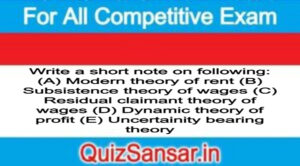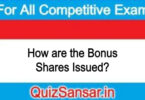
Write a short note on following: (A) Modern theory of rent (B) Subsistence theory of wages (C) Residual claimant theory of wages (D) Dynamic theory of profit (E) Uncertainity bearing theory
Write a short note on following:
(A) Modern theory of rent
(B) Subsistence theory of wages
(C) Residual claimant theory of wages
(D) Dynamic theory of profit
(E) Uncertainity bearing theory
Ans.
(A) Modern theory of rent : Modern theory of rent is an amplified and modified version of Ricardian theory of Rent. It was first of all discussed by J.S. Mill and after that developed by economists like Jevons, Pareto, Marshall, Joan Robinson etc.
According to modern theory, economic rent is a surplus which is not peculiar to land alone. It can be a part of income of labour, capital, entrepreneur.
According to modern version rent is a surplus which arises due to difference between actual earning and transfer earning.
That is:
Rent = Actual Earning – Transfer Earning.
What is Transfer Earning?
In this universe, each factor of production has varied uses. When we transfer one factor from one use to another, we have to sacrifice the income earned by it from its earlier use. Sacrifice of earning is called transfer earning.
Modern Definitions of Rent:
“Rent is a payment in excess of transfer earning.” Stonier and Hague “The essence of the conception of rent is the conception of a surplus earned by a particular part of a factor of production over and above the minimum sum necessary to induce it to do its work”. Mrs. Joan Robinson
Features of Modern Theory of Rent:
The major features of the modern theory of rent are as under:
1. Rent can be a part of the income of all factors of production.
2. Amount of rent depends upon the difference between actual earning and transfer earning.
3. Rent arises when supply of the factor is either perfectly inelastic or less elastic.
(B) Subsistence theory of wages
This theory was propounded by David Recardo (1772-1823). According to this theory, “The labourers are paid to enable them to subsist and perpetuate the race without increase or diminution”. This payment is also called as ‘subsistence wages’. The basic assumption of this theory is that if workers are paid wages more than subsistence level, workers’ number will increase and, as a result wages will come down to the subsistence level.
On the contrary, if workers are paid less than subsistence wages, the number of workers will decrease as a result of starvation death; malnutrition, disease etc. and many would not marry. Then, wage rates would again go up to subsistence level. Since wage rate tends to be at, subsistence level at all cases, that is why this theory is also known as ‘Iron Law of Wages’. The subsistence wages refers to minimum wages.
(C) Residual claimant theory of wages
This theory owes its development to Francis A. Walker (1840-1897). According to Walker, there are four factors of production or business activity. viz., land, labour, capital, and entrepreneurship. He views that once all other three factors are rewarded what remains left is paid as wages to workers. Thus, according to this theory, worker is the residual claimant.
(D) Dynamic theory of profit
Prof. J.B. Clark propounded the dynamic theory of profit in the year 1900. To him profit is the difference between the price and the cost of production of the commodity. Profit is the result of progressive change in an organized society.
The progressive change is possible only in a dynamic state. According to Clark the whole economic society is divided into organized and unorganized society. The organized society is further divided into static and dynamic state. Only in dynamic state profit arises.
In a static state, the five generic changes such as the size of the population, technical knowledge, the amount of capital, method of production of the firms and the size of the industry and the wants of the people do not take place; everything is stagnant and there is no change at all. The element of time is non-existent and there is no uncertainty. The same economic features are repeated year after year.
Therefore there is not risk of any kind to the entrepreneur. The price of the good will be equal to the cost of production. Hence profit does not arise at all. The entrepreneur would get wages for his labour and interest on his capital. If the price of the commodity is higher than the cost of production, competition would reduce the price again to the level of the cost of production so that profit is eliminated.
The presence of perfect competition makes the price equal to the cost of production which eliminates the super normal profit. Thus Knight observes, “Since costs and selling prices are always equal, there can be no profit beyond wages for the routine work of supervision”.
It is well known that the society has always been dynamic. Several changes are taking place in a dynamic society.
(E) Uncertainity bearing theory
This theory was propounded by an American economist Prof. Frank H. Knight. This theory, starts on the foundation of Hawley’s risk bearing theory. Knight agrees with Hawley that profit is a reward for risk-taking. There are two types of risks viz. foreseeable risk and unforeseeable risk. According to Knight unforeseeable risk is called uncertainty beaming.
Knight, regards profit as the reward for bearing non-insurable risks and uncertainties. He distinguishes between insurable and non-insurable risks. Certain risks are measurable, the probability of their occurrence can be statistically calculated. The risks of fire, theft, flood and death by accident are insurable. These risks are borne by the insurance company.
The premium paid for insurance is included in the cost of production. According to Knight these foreseen risks are not genuine economic risks eligible for any remuneration of profit. In other words insurable risk does not give rise to profit.
According to Knight profit is due to non-insurable risk or unforeseeable risk.






